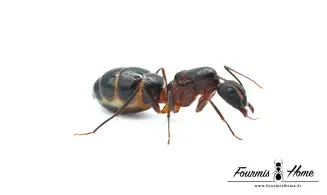

Camponotus barbaricus
Reference : CFOUR-015
14.90€
unavailable
Latin name: Camponotus barbaricus
Taxonomy: Subfamily: Formicinae, Tribe: Camponotini
Breeding level: Beginner
Geographical distribution: Southern Europe to North Africa
Habitat: Prefers open landscapes but avoids arid zones
Colony form: Monogyne
Queen: Size: 16 - 17mm Color: Shiny black
Workers: Size: 7 - 10mm Color: Reddish glossy black
Major: Size 14 - 16mm Color: Reddish glossy black
Male: Size: 10mm Color: Black
Food: Honeydew and insects: like flies, mealworms, mosquitoes and small crickets; also fruits
Humidity: Hunting area: 30 - 50% Nest: 50 - 60%
Temperature: Hunting area: 18 - 28 ° C Nest: 21-25 ° C
Hibernation: Yes mandatory from November to early March between 12-15 ° C
Nest type: Plexiglas nest, nest with tubes, reconstituted stone nest.
Description: Camponotus barbaricus belong to the largest ants in Europe.
Development: Swarming from June to July
Foundation: Set in a cloister (without food) Development: 40 days from egg to worker (depending on temperature)
Size of the colony: 10,000 individuals, the queen can reach the age of 15 years.
Taxonomy: Subfamily: Formicinae, Tribe: Camponotini
Breeding level: Beginner
Geographical distribution: Southern Europe to North Africa
Habitat: Prefers open landscapes but avoids arid zones
Colony form: Monogyne
Queen: Size: 16 - 17mm Color: Shiny black
Workers: Size: 7 - 10mm Color: Reddish glossy black
Major: Size 14 - 16mm Color: Reddish glossy black
Male: Size: 10mm Color: Black
Food: Honeydew and insects: like flies, mealworms, mosquitoes and small crickets; also fruits
Humidity: Hunting area: 30 - 50% Nest: 50 - 60%
Temperature: Hunting area: 18 - 28 ° C Nest: 21-25 ° C
Hibernation: Yes mandatory from November to early March between 12-15 ° C
Nest type: Plexiglas nest, nest with tubes, reconstituted stone nest.
Description: Camponotus barbaricus belong to the largest ants in Europe.
Development: Swarming from June to July
Foundation: Set in a cloister (without food) Development: 40 days from egg to worker (depending on temperature)
Size of the colony: 10,000 individuals, the queen can reach the age of 15 years.

